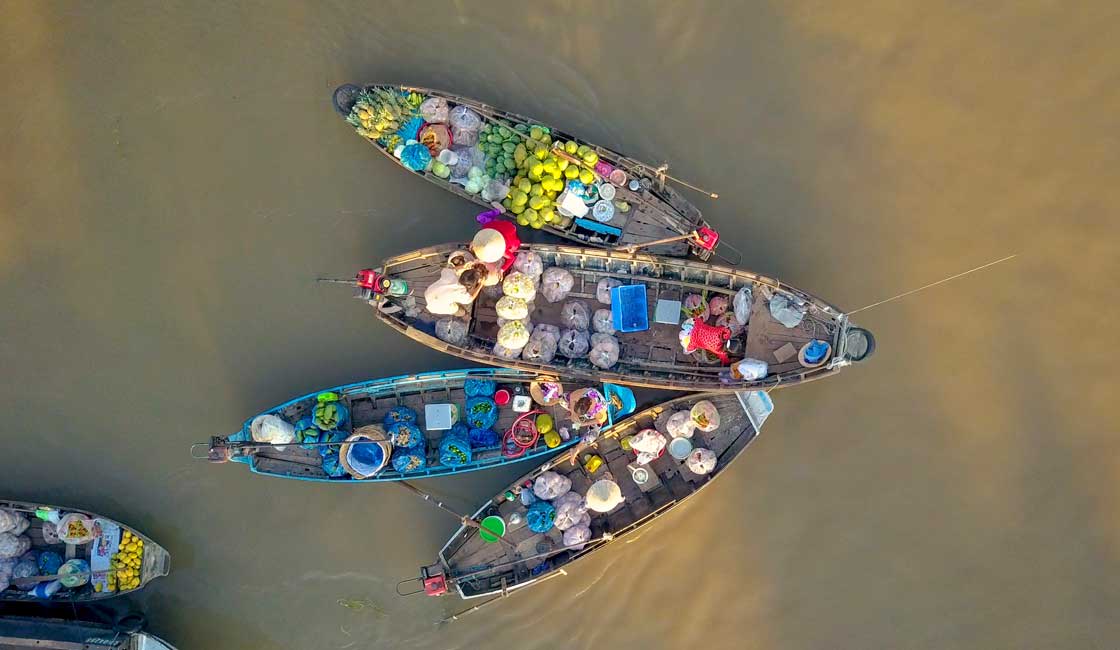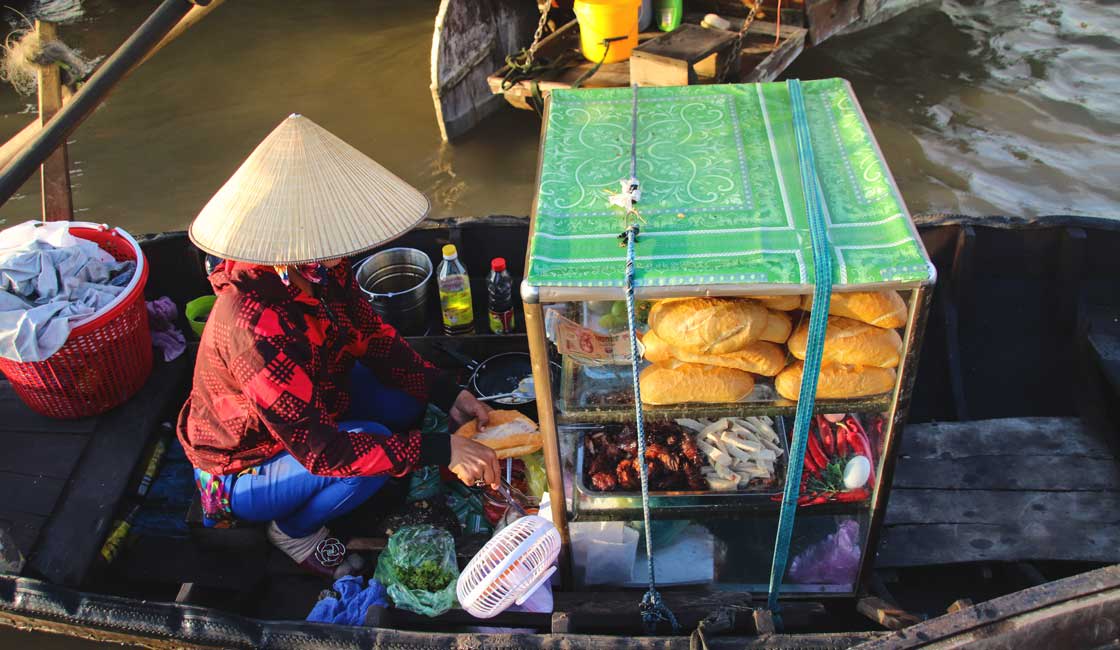
It’s quite hard for anyone to choose which floating market to visit in the Mekong Delta. From the frigid Tibetan Plateau to the warm South China Sea, the Mekong River has defined life in Southeast Asia for thousands of years with its abundant fish population. Not to mention the cool waters that have nurtured civilizations on its banks, and maintained the region’s truly unique culture. Some villages here are able to trace their existence back to the 18th century and beyond.
Scattered along the banks of this energetic hub, divided by the rice paddies, fruit orchards, and mangroves nurtured by ‘Cuu Long’, (the local name in Vietnamese for the awe-inspiring Nine Dragons), are the areas famous floating markets. Some of the famous floating markets are part of the excursions on the Mekong Cruise, to many others you can travel on your own, making it a great part of the Vietnam vacations.

Cai Rang busy market
The smiling faces that greet visitors to the Mekong are also among the most ethnically diverse groups in Southeast Asia with a mix of groups, who migrated to its rich banks from Northern and Central Vietnam, China, Cambodia, and the Malay Peninsula in pre-colonial times. With trading as a tradition, the region has gradually mixed their different cultures into a harmonious common whole, while keeping its most distinctive aspects alive.
In Thailand, visitors flock to the Amphawa floating market, Damnoen Saduak floating market, Taling Chan, and Khlong Lat Mayom – floating markets located mere hours away from Bangkok. In Vietnam; the famous Cai Rang Floating Market, located just three hours drive from Ho Chi Minh City in Tien Giang province, Nga Bay floating market, located at the meeting point of the seven canals and rivers in Nga Bay, along with Nga Nam and Can Tho. However you’re spending your time in Southeast Asia, keep the floating markets on your radar – they are fun and incredibly photogenic.
Cai Rang, perhaps one of the more popular markets, located on the banks of the giant Tien river, one of the tributaries of the Mekong that has been in existence since the 18th century. Cai Rang is a unique experience for many. Unlike other floating markets in Vietnam, which start earlier, the size and scale of Cai Rang allow it to stays open later, attracting visitors that may be turned off by early mornings, without losing any of its charm or vibrancy. The market is a wholesale transportation hub for goods, fruit, and seafood from the Mekong Delta to the rest of Vietnam.
Cai Rang is located just about 45 minutes by the river, or even less on land, via the Cau Dau Sau boat landing and Dau Sau Bridge from Can Tho. Can Tho is a vibrant and energetic city, sitting on the southern bank of the Hau River. Can Tho is in itself a sight to behold, from its Ninh Kiew Wharf, just a few minutes from the city center, to sampan tours, which wiggle through the smaller canals just off the Mekong.
These areas are so special and rare to see, as they are generally inaccessible to larger boats. Can Tho also offers visitors the somber experience of the Can Tho Grand prison, which played a major role during the French and Vietnam War. The cocoa farm offers the opportunity to learn about the fruit and the process of turning its beans and pulp into body butter, chocolate, and even alcohol!

Baguette snack in the market
Nga Bay floating market (also referred to as Phung Hiep) is located just under an hour away by car from Cai Rang, and also offers eye-catching treats to visitors, although of a somewhat different variety. Nga Bay first opened in 1915 and has since then been a key trading point for the locals in Nga Bay town. This market is one of the most popular floating markets among anyone wanting to dive into other aspects of Vietnamese culture. The area is known for its unique Coconut “Factory” situated in one of the largest coconut processing areas in Vietnam, which produces everything from coconut candy to coconut butter and milk.
In Cai Be District, there is the Cai Be floating market, where visitors can see long stretches of caters transporting goods, vegetables, and other items. Cai Be is often a popular choice for tourists, who don’t have much time to venture further south since it is located quite close to Ho Chi Minh City and the fact that it opens as late in the day as Cai Rang.
While Nga Nam market, one of the furthest to the south of the Mekong, also isn’t outdone by its neighbors. Located in Nga Nam province at the epicenter of the Ca Mau, Vinh Quoi, Long My, Thanh Tri, and Phung Hiep interchange. Nga Nam market is famous for its busy atmosphere; many visitors have said no other market in Vietnam compares to the busy atmosphere. On a visit to Nga Man, you will see endless stretches of boats full of produce at almost any time of the day, although the earlier the better.
The area is known for its cabbage, potato, tomato, and garlic, however, it also features specialty goods such as signature types of rice and tropical fruits to countless varieties of seafood. This truly displays the pure range of resources and diversity the Mekong Delta has to offer. Meals are often on sale from the locals just like in regular western markets. The area offers delightful fish noodles, rice, soup, and freshly ground and brewed coffee – the Mekong Delta cuisine having its unique character.
Outside of the wonders of the floating markets in the Mekong delta, visitors often pair their vacations with day trips to the Tram Chim Nation Park in Dong Thap for bird watching. This park spans over 7,500 hectares and is home to up to 250,000 birds! Specifically, over 200 types of birds live here – many of which are rare and endangered. Other popular tours hold visits to the Tan Chau Silk Village in An Giang, home of one of the largest silk-producing areas outside of Hoi An.
While Rainforest Cruises aim to provide accurate and up-to-date information, we make no representations as to the accuracy or completeness of any information herein or found by following any link on this site. Rainforest Cruises cannot and will not accept responsibility for any omissions or inaccuracies, or for any consequences arising therefrom, including any losses, injuries, or damages resulting from the display or use of this information.




